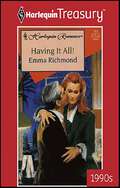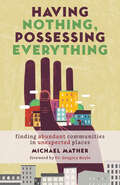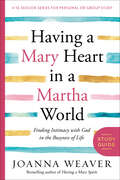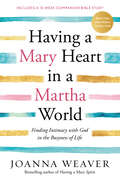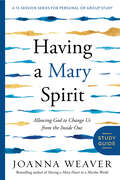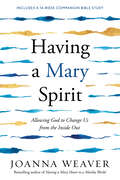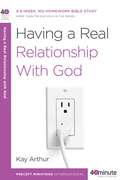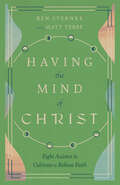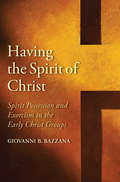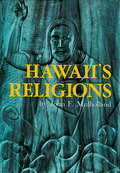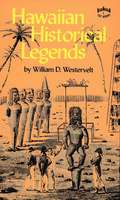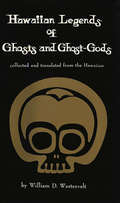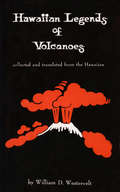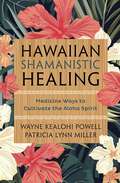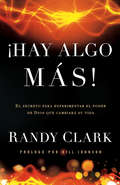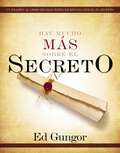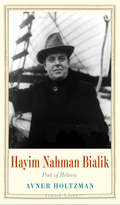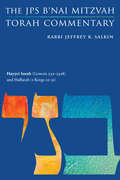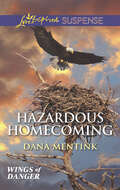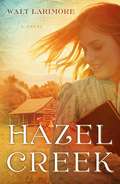- Table View
- List View
Having It All!
by Emma RichmondRowan wanted it all: a man, a marriage and her own company!But her transatlantic romance with Bostonian businessman Arden Harveson had been doomed from the start. Compromise hadn't been in either of their vocabularies and they had parted bitterly. Now Rowan was back in the States, and, while a year's distance hadn't cooled their ardor, it hadn't cooled their heads, either. To Rowan it seemed that wanting Arden was light-years away from having him!"Richmond has a magic way...."-Affaire de Coeur
Having Nothing, Possessing Everything: Finding Abundant Communities in Unexpected Places
by Fr. Gregory Boyle Michael MatherPastor Mike Mather arrived in Indianapolis thinking that he was going to serve the poor. But after his church’s community lost nine young men to violence in a few short months, Mather came to see that the poor didn’t need his help—he needed theirs.This is the story of how one church found abundance in a com-munity of material poverty. Viewing people—not programs, finances, or service models—as their most valuable resource moved church members beyond their own walls and out into the streets, where they discovered folks rich in strength, talents, determination, and love.Mather’s Having Nothing, Possessing Everything will inspire readers to seek justice in their own local communities and to find abundance and hope all around them.
Having Nothing, Possessing Everything: Finding Abundant Communities in Unexpected Places
by Michael MatherPastor Mike Mather arrived in Indianapolis thinking that he was going to serve the poor. But after his church&’s community lost nine young men to violence in a few short months, Mather came to see that the poor didn&’t need his help—he needed theirs.This is the story of how one church found abundance in a com-munity of material poverty. Viewing people—not programs, finances, or service models—as their most valuable resource moved church members beyond their own walls and out into the streets, where they discovered folks rich in strength, talents, determination, and love.Mather&’s Having Nothing, Possessing Everything will inspire readers to seek justice in their own local communities and to find abundance and hope all around them.
Having Nothing, Possessing Everything: Finding Abundant Communities in Unexpected Places
by Michael MatherPastor Mike Mather arrived in Indianapolis thinking that he was going to serve the poor. But after his church&’s community lost nine young men to violence in a few short months, Mather came to see that the poor didn&’t need his help—he needed theirs.This is the story of how one church found abundance in a com-munity of material poverty. Viewing people—not programs, finances, or service models—as their most valuable resource moved church members beyond their own walls and out into the streets, where they discovered folks rich in strength, talents, determination, and love.Mather&’s Having Nothing, Possessing Everything will inspire readers to seek justice in their own local communities and to find abundance and hope all around them.
Having a Mary Heart in a Martha World Study Guide: Finding Intimacy with God in the Busyness of Life
by Joanna WeaverThey were two of Jesus's closest friends. Each had something to offer Him. But one offered "the better part." In Joanna Weaver's signature book, Having a Mary Heart in a Martha World, she explores how each of us has some "Mary" and some "Martha" within. The "Mary" in us wants to leave the dishes and sit at Jesus's feet, while the "Martha" in us wants to attend to the multiple tasks around us. How do we blend intimacy with Jesus and service for Him in the midst of our busy, hectic lives? In this ten-session DVD companion participant's guide, Joanna reminds us that Jesus extends to us the same invitation He gave these sisters of Bethany: Come to Me. As we discover the best of both the "Mary" and the "Martha" parts of our lives, we will deepen our devotion to God and learn to delight in sitting at His feet. Designed for individuals and groups.
Having a Mary Heart in a Martha World: Finding Intimacy with God in the Busyness of Life
by Joanna WeaverWith nearly a million copies sold, Joanna Weaver's popular book shows women how to blend intimacy with Jesus and service for Him. An invitation for every woman who feels she isn't godly enough...isn't loving enough...isn't doing enough. The life of a woman today isn't really all that different from that of Mary and Martha in the New Testament. Like Mary, you long to sit at the Lord's feet...but the daily demands of a busy world just won't leave you alone. Like Martha, you love Jesus and really want to serve him...yet you struggle with weariness, resentment, and feelings of inadequacy. Then comes Jesus, right into the midst of your busy Mary/Martha life-and he extends the same invitation he issued long ago to the two sisters of Bethany. Tenderly he invites you to choose "the better part"-a joyful life of "living-room" intimacy with him that flows naturally into "kitchen service" for him. How can you make that choice? With her fresh approach to the familiar Bible story and its creative, practical strategies, Joanna shows how all of us -Marys and Marthas alike- can draw closer to our Lord, deepening our devotion, strengthening our service, and doing both with less stress and greater joy. This book includes a twelve-week Bible study. Also look for the ten-week DVD study pack companion product to this book, which includes three DVDs and a separate, revised and expanded study guide.
Having a Mary Spirit Study Guide
by Joanna WeaverTransformation. We want it. We know we need it. But how do we access the new life Jesus came to bring? In her best-selling book, Having a Mary Spirit, Joanna Weaver explores the "Holy Makeover" God wants to give each one of us. Dealing with topics such as guarding our hearts, managing our thought lives, and overcoming the "Flesh Woman" in us all, Joanna takes us to the Word of God and the power of grace to transform our lives.Changed by God - from the inside out.This twelve-session study guide, for use with Joanna's book and companion DVDs, helps us draw closer to God, revealing spiritual insights and modern-day applications from his Word. As we open our hearts to God's grace, his love, and the Holy Spirit's power, brings the change we long for. The transformation we need.Designed for both individuals and groups. Meant to be used with Having a Mary Spirit book. Companion DVDs, consisting of twelve 18- to 20-minute sessions are also available.
Having a Mary Spirit: Allowing God to Change Us from the Inside Out (Walker Large Print Ser.)
by Joanna Weaver“Lord, Whatever It Takes, Make Me Like You!” You long to serve God with grace and strength, to reflect Christ in every word and action. Yet you find yourself continually struggling to bring that vision to life in your daily walk. At our very core, every one of us is a “twisted sister” within whom the flesh and spirit battle constantly for control. We are afflicted with spiritual schizophrenia, the disconnect between our “good girl” desire to put Jesus first and our “bad girl” realities that crowd our thoughts and push him out of the way. In this life-changing book, Joanna Weaver, author of the perennial bestseller,Having a Mary Heart in a Martha World, directs your gaze past your own shortcomings to the God who stands ready, willing, and able to make a new woman out of you. She equips you with biblical insights and practical tools to partner with Christ, inviting him into the hidden places of your soul and giving him full permission to redeem and renovate. Drawing on the stories of biblical Marys and others whose experience with God transformed their lives, Joanna shows how you can find the hope, healing, wholeness, and joy your heart longs for. Having a Mary Spiritwill launch you toward lasting personal transformation–soul-deep change that results in a complete makeover, from the inside out. **Includes a 12-week Bible study for both individual reflection and group discussion**
Having a Real Relationship with God (40-Minute Bible Studies)
by Kay ArthurThis Bible study series from beloved Bible teacher Kay Arthur and the teaching staff of Precept Ministries tackles important issues in brief, easy-to-grasp lessons you can benefit from personally or as part of a small group. Each book in the series includes six 40-minute studies designed to draw you into God’s Word through basic inductive Bible study. As Kay explains, "Rather than simply reading or listening to what others say about a subject, you are going to see for yourself what God says about it. "Join one of the world’s most respected Bible teachers in a study that will revolutionize your thinking--and your life. Have you ever wondered if it’s possible to have a meaningful and authentic relationship with God--one that really works in the day-in-day-out circumstances of your life? This powerful inductive study will help you discover for yourself how such a rewarding relationship with God is possible. Kay Arthur opens the Bible to show you the way to salvation, with a special focus on where you stand with God, how your sin keeps us from knowing him, and how Christ bridged the chasm between humanity and God. Begin your journey to genuine faith. Let Kay Arthur show you the way!
Having the Mind of Christ: Eight Axioms to Cultivate a Robust Faith
by Matt Tebbe Ben Sternke"Why doesn’t the Christian life work like I thought it would?"Having the Mind of ChristbehaviorsPastors Matt Tebbe and Ben Sternke share eight axioms that help reframe the way that we see God, ourselves, and others. By seeing through new lenses, we can open ourselves to the transformational change that God wants for our lives.
Having the Spirit of Christ: Spirit Possession and Exorcism in the Early Christ Groups (Synkrisis)
by Giovanni B. BazzanaA provocative reinterpretation of accounts of spirit possession and exorcism in early Christianity The earliest Christian writings are filled with stories of possession and exorcism, which were crucial for the activity of the historical Jesus and for the practice of his earliest followers. Possession, besides being a harmful event that should be exorcized, can also have a positive role in many cultures. Often it helps individuals and groups to reflect on and reshape their identity, to plan their moral actions, and to remember in a most vivid way their past.
Hawaii's Religions
by John Field MulhollandThis is a comprehensive guide to religion in Hawaii. Beginning with the religion of ancient Hawaii, depicting the arrival of the first missionaries, and, religion by religion, covering each faith as it came to Hawaii, the author thoroughly describes the inception and harmonious development of Hawaiian religions. Christianity, Judaism, Japanese and Chinese Buddhism, Shinto, the new religions from Japan (such as Tenrikyo), Baha'ism, and other religions are discussed, their leaders indicated, and their present standing in Hawaii given. Hawaii's Religions fills a gap in the library of Hawaiian literature. As a textbook, as a reference book, or for pleasure reading, it cannot be welcomed by those interested in Hawaiian culture.
Hawaii's Religions
by John Field MulhollandThis is a comprehensive guide to religion in Hawaii. Beginning with the religion of ancient Hawaii, depicting the arrival of the first missionaries, and, religion by religion, covering each faith as it came to Hawaii, the author thoroughly describes the inception and harmonious development of Hawaiian religions. Christianity, Judaism, Japanese and Chinese Buddhism, Shinto, the new religions from Japan (such as Tenrikyo), Baha'ism, and other religions are discussed, their leaders indicated, and their present standing in Hawaii given. Hawaii's Religions fills a gap in the library of Hawaiian literature. As a textbook, as a reference book, or for pleasure reading, it cannot be welcomed by those interested in Hawaiian culture.
Hawaiian Historical Legends
by William D. WesterveltThis literary treasure provides one of the earliest glimpses into pre-colonial Hawaaiin culture.This book, one of six written by Dr. Westervelt, is a fascinating compilation of Hawaiian legends and historical tales. The origins of the Hawaiian people, the demi-god Maui's search for immortality for mankind, the coming of Captain Cook, the wars of King Kamehameha, as well as other aspects of Hawaii's incredible history fill its pages. Librarians, students, collectors, and anyone who enjoys reading about ancient Hawaii will delight in Hawaiian Historical Legends. Dr. Westervelt is one of the best-known raconteurs of Hawaiian stories.Hawaiian Historical Legends presents a variety of stories both legendary and historical. The author also considers the question of Polynesian origins and the speculative subject of Spanish visitants.Other titles n this series on Hawaii include: Hawaiian Legends of Ghosts and Ghost Gods, and Hawaiian Legends of Old Honolulu Hawaiian Legends of Volcanoes.
Hawaiian Legends of Ghosts and Ghost-Gods
by William D. Westervelt1916. A diverse collection of the legends of the Hawaiian Islands. Contents Part I-Legends: The Ghost of Wahaula Temple; Maluae and the Underworld; A Giant's Rock Throwing; Kalo-Eke-Eke, The Timid Taro; Legendary Canoe Making; Lau-Ka-Ieie; Kauhuhu, the Shark God of Molokai; The Shark Man of Waipio Valley; the Strange Banana Skin; The Old Man of the Mountain; Hawaiian Ghost Testing; How Milu Became the King of Ghosts; A Visit to the King of Ghosts; Kalai-Pahoa, the Poison God; Ke-Ao-Mele-Mele, the Maid of the Golden Cloud; Poona and the Dragon; Ke-Au-Nini; and The Bride from the Underworld. Part II- Description: The Deceiving of Kewa; Homeless and Desolate Ghosts; Aumakuas or Ancestor Ghost Gods; The Dragon Ghost Gods; and Home of the Ancestors.
Hawaiian Legends of Volcanoes
by W. D. WesterveltInterspersed with legends of the fire goddess Pele, the lightning goddess Hiiaka, and others, are nuggets of related geological and historical information. First published in 1916, this book has a four-page appendix and notes on Polynesian language.
Hawaiian Legends of Volcanoes
by William D. Westervelt"A richly entertaining series of Hawaiian tales with explanatory facts, which will delight and inform both the folklore fan and the general reader..." -The Honolulu AdvertiserHawaiian Legends of Volcanoes made its first appearance in 1916, in both American and British editions, as the third in a series that represented a pioneering study of Hawaiian folklore. The rich tradition of Hawaiian legends is showcased in it's purest form, making this an essential read for anyone living in Hawaii who wants to understand the local culture or anyone interested in classical folklore. The book also includes a study of Hawaiian geology, which is essential to understanding how the Hawaiian religion and classical Hawaiian stories developed.Legends and stories include: Ai-Au, The Forest Eater Pele and the Owl Ghost-God Hiiaka's Battle with the Demons The Annihiation of Keoua's Army Kapiolani and Pele and many more...Other volumes in the series about Hawaiian culture and history are Hawaiian Legends of Ghosts and Ghost-Gods and Hawaiian Legends of Old Honolulu.
Hawaiian Shamanistic Healing: Medicine Ways to Cultivate the Aloha Spirit
by Patricia Miller Wayne Kealohi PowellBring the Peace of Paradise Into Your Life Every Day, No Matter Where You AreAloha refers to the divine spirit of love that flows through all things. In this book, you'll learn how to cultivate the Aloha spirit with Hawaiian philosophy, Ho'oponopono, Lomilomi massage, and other traditional medicine ways. Hawaiian Shamanistic Healing explores the techniques of several renowned healing systems, including Kahi Loa, Heartworks Lomi, Big Island Massage, Traditional Hawaiian Touch Medicine, and Temple Style Lomi.Join authors Wayne Kealohi Powell and Patricia Lynn Miller, longtime students and practitioners of Hawaiian bodywork and shamanism, as they show you how to create space for miracles and open up to the healing energy of the divine.Praise:"My first experience of receiving bodywork from Wayne in 2003 was profound, and I have been hooked ever since. I have been involved in body work for many years and have had hundreds of body work sessions internationally. What makes Wayne's sessions so profound is the depth he takes me to and the magic that gets evoked for weeks after my sessions. I literally feel all old baggage fall off, injuries healing fast, and my energy shiny, new, and ready to take on the world from a place of heart and soul. I now make receiving Wayne's healing work part of my lifestyle and a must for my family and the clients I mentor. I urge you to experience, learn, and dive into Wayne's magic and I assure you that you'll be gifting yourself a spa-healing for your body, mind, and soul."—Satyen Raja, founder of Warrior Sage Trainings"...The mature lomilomi practitioner, no matter the franchise, always lives within the current of authority to heal. The core relationship between the soul and the practitioner is the maturing process. When that happens; the healing that follows is immortal. The place we hold for lomilomi is far reaching, so many practitioners have far moved past the certificates on their wall and into their own expression. In that expression is the non-franchised, authentic relationship between soul and person, carrying the healing that is known as lomilomi. And Wayne and Patti's effort in this book speaks to all lineages in a single voice."—Harry Uhane Jim, Kahuna, healer, teacher, and author of Wise Secrets of Aloha"Many are the techniques for revitalizing and relaxing the body temple, but there is only one that delivers the results of Wayne's Lomilomi techniques. Wayne's unique combination of Lomilomi and ancient breath work promotes the integration of healthy new choices while releasing old ones. In short it is a transforming gift to yourself!"—Rev. Dr. Michael Bernard Beckwith, founder and senior minister of Agape International Spiritual Centre, and author of Life Visioning
Hay algo más: El secreto para experimentar el poder de Dios que cambiará su vida
by Randy Clark¿Qué tal si "más" es bíblico? ¿Incluso esencial? Dios no es un DIos de limosnas cuidadosamente medidas. El anhela darle más, tanto como usted esté dispuesto a recibir. Más amor. Más poder. Más fe. Más gozo. Más resultados en la oración. Con su peculiar perspicacia y motivación, Randy Clark explica que "más" no es sólo bíblico, sino indispensable para dar mayores frutos en el servicio y el ministerio. Además, comparte cómo puede accesar lo que Dios quiere darle. Todo comienza con la gracia. La gracia es más que recibir la vida eterna. Es la forma en que experimentamos la presencia y el poder de Dios en nuestras vidas, y cómo Él nos da el poder para hacer más de lo que imaginamos. Él quiere darle más. Quiere que usted sea una vaso de su gloria. Él quiere llenarle con su Espíritu y sus dones. ¿Acepta el reto?
Hay mucho más sobre El secreto: Un examen al libro de gran éxito de Rhonda Byrne, El secreto
by Ed GungorLa ley de la atracción sostiene que uno puede gozar de buena salud, riquezas o cualquier relación deseada si se entrena a la mente a producir pensamientos continuos que la atraigan a su vida. Aunque hay algo de cierto en el hecho de que tendemos a convertirnos en lo que pensamos (el apóstol Pablo nos enseñó eso), la representación que hace la filosofía de la nueva era de mostrar al "individuo como Dios" es una posición peligrosa de sostener.En este libro que acompaña al revuelo causado en los medios de comunicación, Ed Gungor trata de establecer una representación más completa y precisa del poder de la mente explicando el papel obvio que desempeña Dios en la ecuación. Este libro no está escrito para atacar a publicaciones recientes sino para corregir su consejo equivocado y a la vez dirigirse a la gran necesidad que está causando que millones de personas estén explorando sus páginas.
Hayim Nahman Bialik: Poet of Hebrew (Jewish Lives)
by Prof. Avner HoltzmanA moving inquiry into the dramatic life, epic success, and ultimate tragedy of the great Hebrew poet By the time he was twenty-eight, Hayim Nahman Bialik was already considered the National Hebrew Poet. He had only published a single collection, but his deeply personal poetry established a profound link between the secular and the traditional that would become paramount to a national Jewish identity in the twentieth century. When he died unexpectedly in 1934, the outpouring of grief was unprecedented, confirming him as a father figure for the Zionist movement in Palestine, and around the world. Using extensive research and elegant readings of Bialik's poems, Avner Holtzman investigates the poet's dramatic life, complex personality, beloved verse, and continued popularity. This clear-eyed and thorough biography explores how Bialik overcame intense personal struggles to become a charismatic literary leader at the core of modern Hebrew culture.
Hayyei Sarah: The JPS B'nai Mitzvah Torah Commentary (JPS Study Bible)
by Rabbi Jeffrey K. SalkinHayyei Sarah (Genesis 23:1-25:18) and Haftarah (1 Kings 1:1-31): The JPS B’nai Mitzvah Torah Commentary shows teens in their own language how Torah addresses the issues in their world. The conversational tone is inviting and dignified, concise and substantial, direct and informative. Each pamphlet includes a general introduction, two model divrei Torah on the weekly Torah portion, and one model davar Torah on the weekly Haftarah portion. Jewish learning—for young people and adults—will never be the same. The complete set of weekly portions is available in Rabbi Jeffrey K. Salkin’s book The JPS B’nai Mitzvah Torah Commentary (JPS, 2017).
Hazardous Homecoming (Wings of Danger #1)
by Dana MentinkNew evidence in a missing persons case stirs up long-buried emotions in this inspirational romantic suspense novel by a USA Today–bestselling author.Ruby Hudson finds new evidence that could shed light on her childhood friend’s disappearance. But she’ll have to fight for her life to keep it out of the wrong person’s hands. Cooper Stokes’s brother is still the prime suspect, and as the cold case heats up, so do Ruby’s forgotten feelings for Cooper. Ruby wants justice for her friend. Cooper wants to prove his brother’s innocence. Despite being on opposite sides, they find themselves drawn to one another. But the deeper they dig into decades-old secrets, the closer they come to having to make a choice between family and love.
Hazel Creek
by Walt LarimoreIn the Hazel Creek Valley of the Great Smoky Mountains, Nathan and Callie Randolph, with their five unique daughters, wrestle to maintain their farm, forests, family, and faith against an unforgiving wilderness. An evil lumber company manager is seeking by every means possible to pilfer their land and clear-cut their virgin forest. A cast of colorful characters, including a menacing stranger, gypsy siblings, a granny midwife, and a world-famous writer--even a flesh-and-blood Haint--collide in a gripping struggle of good and evil amid eruptions of violence and tragedy. Our heroine, fifteen-year-old Abbie Randolph, has to help save her family's farm and raise her sisters while preserving her faith. This important story, based on almost ten years of research and four years of living in the area, captures the speech, ways, and beliefs of these unique pioneers at a crucial and irreversible turning point in this Smoky Mountains community of the Southern Appalachians. With the march of the industrial age, especially commercial lumbering, the traditional life and ways of our southern highlanders in general, and the Randolphs in particular, were about to change forever.
Hazel Creek: A Novel
by Walt LarimoreIn a new novel from award-winning author Walt Larimore, a loving rural family struggles to survive tragedy and cope with the invasion of modern ways in the 1920s.In the Great Smoky Mountains wilderness in 1925, Nathan and Callie Randolph, with their five unique daughters, struggle to maintain their farm, forests, family, and faith against a menacing business and an evil company manager trying to pilfer their land and clear cut their forest.As loggers invade the mountains, death touches the family, and hardship and loss confront them again and again; fifteen-year-old Abbie Randolph becomes mother to her sisters and leans on her faith to guide her through the emotional wilderness of changing times. With the march of the industrial age, the roaring twenties, Prohibition, the increasing momentum for national parks, and the onslaught of a modern world, the traditional life and ways of the mountaineers were about to change forever.Featuring a cast of colorful characters, including independent and earnest mountain families, a murderous lumber company manager, Cherokee Indians, a band of gypsies, desperados, lumbermen, moonshiners, a world-famous writer, and Civil War heroes, Hazel Creek reveals a gripping struggle of good and evil during an eruption of violence.A beloved family physician, Walt Larimore is the perfect author for this novel of love, loss, and injury that illuminates the enduring power of faith.
